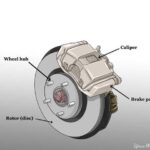When it comes to automotive repair and maintenance, identifying the correct car part is crucial. Using the wrong part can lead to performance issues, safety hazards, and wasted time and money. That’s where understanding how to Look Up Car Part Numbers becomes an invaluable skill, whether you’re a seasoned mechanic or a DIY enthusiast working on your own vehicle.
Car part numbers are unique identifiers assigned by manufacturers to each specific component of a vehicle. These numbers act like a precise address, ensuring you get the exact replacement part you need. They eliminate guesswork and confusion, especially when dealing with complex systems or subtle variations within vehicle models and years.
Why is Knowing the Car Part Number Important?
Imagine needing to replace a brake pad for your car. While you might know the make and model of your vehicle, there can be multiple brake pad types depending on the year, trim level, and even specific production dates. Simply asking for a “brake pad for a [Your Car Make and Model]” might result in getting the wrong part. However, if you can look up the car part number, you guarantee compatibility.
Here’s why knowing the car part number is essential:
- Ensures Correct Fit: The primary reason is to get the right part that fits perfectly and functions as intended. Car part numbers specify dimensions, materials, and compatibility with specific vehicle systems.
- Avoids Compatibility Issues: Vehicles are complex, and even parts that look similar might have crucial differences in specifications. Using the correct part number prevents installation problems and potential damage.
- Saves Time and Money: Ordering the wrong part leads to delays, return hassles, and potentially additional shipping costs. Looking up the car part number upfront saves time and prevents financial losses.
- Access to Accurate Information: Once you have the car part number, you can easily access detailed information about the part, including specifications, diagrams, and even safety data sheets (SDS).
Where to Find Car Part Numbers
Locating the car part number can sometimes be straightforward, while other times it requires a bit of searching. Here are common places to find them:
- On the Part Itself: Many car parts have the part number directly printed or stamped on them. Look for labels, stickers, or engravings on the component. This is often the most reliable source.
- Vehicle Owner’s Manual: Some owner’s manuals, especially for older vehicles, might list part numbers for common replacement items like filters or belts.
- Original Packaging: If you still have the packaging from a previously replaced part, the part number is usually printed on the label.
- Dealership or Manufacturer Websites: Dealerships and official manufacturer websites often have parts catalogs where you can look up car part numbers based on your vehicle’s VIN (Vehicle Identification Number).
- Online Auto Parts Retailers: Reputable online auto parts stores allow you to search for parts using your VIN or vehicle details, and they will display the corresponding part numbers.
- Repair Manuals and Diagrams: Detailed repair manuals or online parts diagrams will often list the part numbers for components shown in the illustrations.
Using Car Part Numbers to Find Safety Data Sheets (SDS)
Once you look up the car part number and identify the specific automotive product you need, especially chemicals or repair materials, accessing the Safety Data Sheet (SDS) becomes crucial for safety and proper handling.
SDS files, previously known as Material Safety Data Sheets (MSDS), are essential documents that provide comprehensive information about a substance or mixture for use in workplace chemical management. For automotive repair, SDS files are particularly relevant for products like:
- Paints and Primers: Knowing the SDS for auto body paints, primers, clear coats, and catalysts is vital for understanding VOC content, flammability, health hazards, and safe application procedures.
- Cleaners and Degreasers: Brake cleaners, engine degreasers, and other automotive cleaners often contain chemicals that require careful handling and disposal. SDS files provide guidelines for safe use and environmental considerations.
- Lubricants and Fluids: Motor oils, transmission fluids, brake fluids, and other automotive fluids have specific chemical compositions. SDS files detail their properties, potential hazards, and safe disposal methods.
- Adhesives and Sealers: Body panel adhesives, seam sealers, and weatherstrip adhesives used in auto body work require understanding of their chemical properties and safe application.
Websites like cardiagxpert.com often provide a valuable resource by linking SDS files to specific automotive product names or part numbers. By looking up your car part number and then searching for SDS files related to that part or product category (like “Parts Master” or “Perfect Stop” as seen in the original document), you can access critical safety information.
Example: Finding SDS Files for Auto Body and Parts Master Products
Let’s say you are using “Parts Master® Carb and Choke Cleaner” with part number 1736. By looking up “Parts Master 1736 SDS” online or on a website like cardiagxpert.com, you should be able to locate and download the Safety Data Sheet for this specific product.
Similarly, if you’re working with “Auto Body Master” paints or primers, knowing the specific product name and potentially a product code (which acts like a part number within a product line) will help you find the relevant SDS. For example, if you are using “HSC1/HSC4 – High Speed Clear Clear,” you can search for “HSC1 HSC4 SDS” to find safety information about this clear coat product.
Conclusion
In the automotive repair world, precision and safety are paramount. The ability to look up car part numbers is a fundamental skill that ensures you use the correct components for repairs and maintenance. Furthermore, understanding how to use these part numbers to access Safety Data Sheets provides crucial information for handling automotive chemicals and materials safely and responsibly. By mastering both looking up car part numbers and utilizing SDS resources, you can enhance the quality of your work, save time and money, and prioritize safety in every automotive project.
